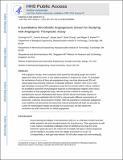A quantitative microfluidic angiogenesis screen for studying anti-angiogenic therapeutic drugs
Author(s)
Kim, Choong; Kasuya, Junichi; Jeon, Jessie S; Chung, Seok; Kamm, Roger Dale
DownloadKamm_A quantitative microfluidic.pdf (1.137Mb)
OPEN_ACCESS_POLICY
Open Access Policy
Creative Commons Attribution-Noncommercial-Share Alike
Terms of use
Metadata
Show full item recordAbstract
Anti-angiogenic therapy, which suppresses tumor growth by disrupting oxygen and nutrient supply from blood to the tumor, is now widely accepted as a treatment for cancer. To investigate the mechanisms of action of these anti-angiogenesis drugs, new three dimensional (3D) cell culture-based drug screening models are increasingly employed. However, there is no in vitro high-throughput screening (HTS) angiogenesis assay that can provide uniform culture conditions for the quantitative assessment of physiological responses to chemoattractant reagents under various concentrations of anti-angiogenesis drugs. Here we describe a method for screening and quantifying the vascular endothelial growth factor (VEGF)-induced chemotactic response on human umbilical vein endothelial cells (HUVECs) cultured with different concentrations of bortezomib, a selective 26S proteasome inhibitor. With this quantitative microfluidic angiogenesis screen (QMAS), we demonstrate that bortezomib-induced endothelial cell death is preceded by a series of morphological changes that develop over several days. We also explore the mechanisms by which bortezomib can inhibit angiogenesis.
Date issued
2014-11Department
Massachusetts Institute of Technology. Department of Biological Engineering; Massachusetts Institute of Technology. Department of Mechanical Engineering; Singapore-MIT Alliance in Research and Technology (SMART)Journal
Lab Chip
Publisher
Royal Society of Chemistry (Great Britain)
Citation
Kim, Choong, Junichi Kasuya, Jessie Jeon, Seok Chung, and Roger D. Kamm. “A Quantitative Microfluidic Angiogenesis Screen for Studying Anti-Angiogenic Therapeutic Drugs.” Lab Chip 15, no. 1 (2015): 301–310. doi:10.1039/c4lc00866a.
Version: Author's final manuscript
ISSN
1473-0197
1473-0189